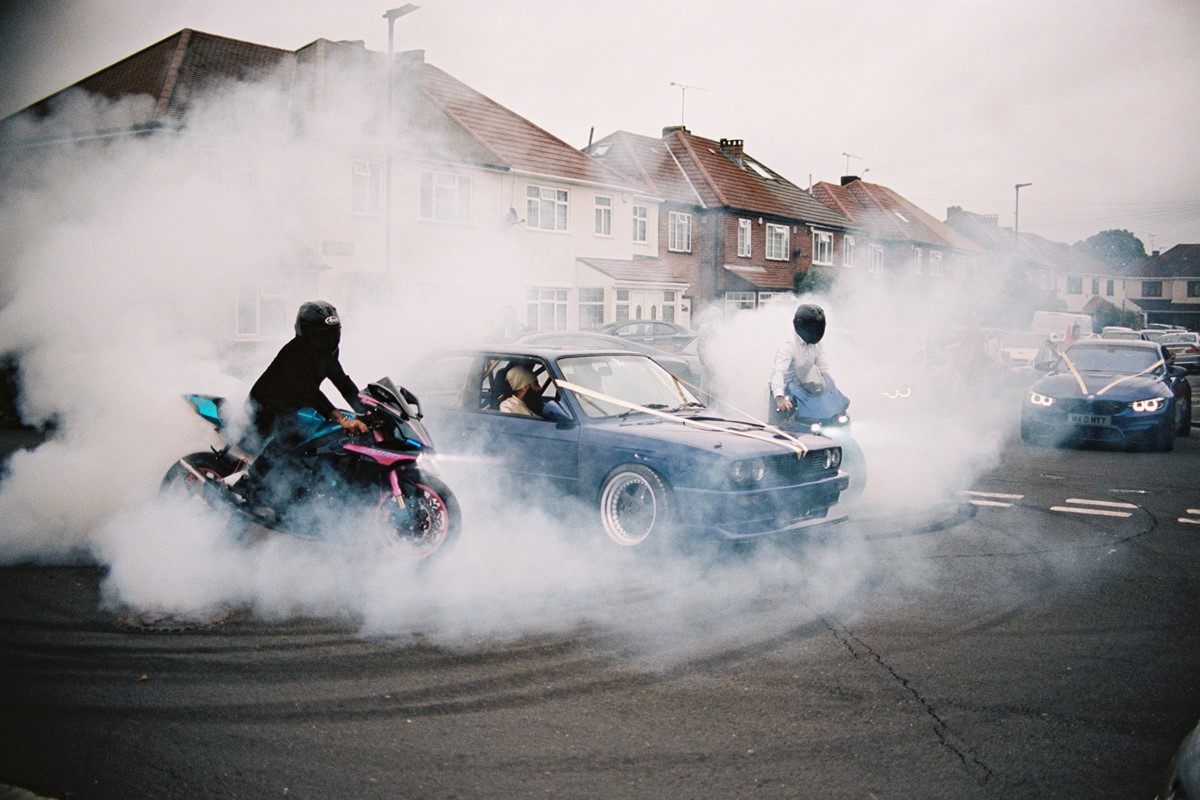Rewrite
The newly released book Zimmers of Southall by photographer Hark1karan not only tells the story of youth classic-car culture in west London, it explores wider British Panjabi identity in the area. If the UK is now our home, then Southall is our capital city.
For Hark1karan, focusing on Southall enables him to share a “universal human story”. Despite being a south Londoner, it’s important to him to “document the lives of his community” here and abroad. “Southall is a place that people from the Panjabi community gather towards,” he tells Dazed. “There isn’t just one thing about Southall, there’s multiple things. It’s music, it’s cars, it’s food.” The car of choice for many Southallians is the BMWs, known affectionately as “beamers” or “zimmers”, many of these cars and their owners are featured in the book.
As a Southall resident and BMW owner growing up in the 90s and 00s, I vividly remember walking all the way back home from The Broadway one rainy afternoon after a Vaisakhi Nagar Kirtan – a Sikh new year festival which sees thousands take to the streets each year. Once dusk fell, Southall Broadway was transformed. As the people running the stalls from earlier in the day packed up their pitches, the sounds of blaring basslines, beeping horns and the bellowings of “HAPPY VAISAKHI!” filled the streets. The cars had come to a standstill, by design. People were standing on their bonnets, waving their flags. Children were leaning out of car windows waving their miniature versions. Similar evenings happened throughout the year whether, it was the last night of Ramadan or after a cricket match between India and Pakistan. Unofficial street parties and Broadway cruises were very much a part of the fabric of Southall culture – and the result of a wider Southall obsession with showing off your car.
It was part of the culture, it was all about having the best, lowest and loudest B-Line BMW – Kavaljeet Singh Bhamra
Kavaljeet Singh Bhamra is a Southall resident, BMW owner and Broadway cruiser from the 1990s. He is featured in the archival images from the book as well as a recent image of the crew still flexin’ their Zimmers at the Osterley Car show for classic cars. Bhamra remembers his cruising days fondly. “Looking at the reflection of our cars in the shop windows as we cruise past with our B-Lines blasting out… everyone knew us few Singhs because of our bright jackets and our BMWs. It was part of the culture, it was all about having the best, lowest and loudest B-Line BMW.”
Car culture was passed down to Bhamra and his friends from their parents, many who had migrated from East Africa in the 1960s and 1970s, where Indians enjoyed attending and partaking in Safari Rally Car driving. Some born here, and some who moved here too young to remember ‘home’, found themselves without the pressure their parents had with limited resources and language skills, but having to contend with often violent fascism from groups such as the National Front. The pressure this group had was the need to ‘make it’, to stick up for themselves, to make sure the suffering and pain they and their parents were enduring was worth the hassle. Cars were a way Panjabis could start establishing a new identity for themselves; as British Panjabis. By the 1980s, Panjabi youth identity in Southall had taken a darker turn – tensions became insular and a gang culture formed in the underbelly of Southall as the Holy Smokes and the Tooti Nungs battled for ownership of The Broadway, often spotted cruising in Stags, Capris or Granadas.
Showing off your car wasn’t for an external audience. Car owners were driving around in their rides just a few streets away from where they lived. Displaying their pride and joy was to show members of their own community they had made it, giving each other and themselves the comfort that they were doing OK; that the sacrifices their parents or their older aunties and uncles had to endure from leaving (and being kicked out) of the countries they were born and raised in, was worth it.
Discussing the inception of the Zimmers of Southall, Hark1karan explains it began when friends invited him to their houses or family weddings and he quickly realised “there’s a story to tell here; and a lot of BMWs”. For me, as a young woman growing up in this community, learning to drive and owning a BMW in the midst of ‘lad’ culture in the early 00s was all about leaning into the dominant culture and proving we were as capable as the boys. Now, when I look back, I see it as a part of a long history of Southall and a space for young people, no matter their gender, to express themselves through car ownership.
The book’s exploration of Southall finds OG cruisers still going strong as a new generation of Southall youth passing their driving tests are buying, collecting, restoring and showing off classic cars. The types of cars that would have been paraded up and down The Broadway are now a returning feature to west London: the Uxbridge Road, Lady Margaret Road and the A40. In and around Southall you’ll find a fleet of classic and modern BMWs at wedding events, birthdays and even funerals; and sometimes just because it’s Sunday. To me, it felt as though the Southall experience was a unique one and many aspects of it are. Through Harkaran’s lens, he helped to explain that it’s also simply “a human story about human being… just normal people who are passionate about culture, music, weddings and cars’”.
Hark1karan’s Zimmers of Southall is launching at The Photo Book Cafe, London, on October 31 (RSVP here). The book is available to order here.
in HTML format, including tags, to make it appealing and easy to read for Japanese-speaking readers aged 20 to 40 interested in fashion. Organize the content with appropriate headings and subheadings (h1, h2, h3, h4, h5, h6), translating all text, including headings, into Japanese. Retain any existing
tags from
The newly released book Zimmers of Southall by photographer Hark1karan not only tells the story of youth classic-car culture in west London, it explores wider British Panjabi identity in the area. If the UK is now our home, then Southall is our capital city.
For Hark1karan, focusing on Southall enables him to share a “universal human story”. Despite being a south Londoner, it’s important to him to “document the lives of his community” here and abroad. “Southall is a place that people from the Panjabi community gather towards,” he tells Dazed. “There isn’t just one thing about Southall, there’s multiple things. It’s music, it’s cars, it’s food.” The car of choice for many Southallians is the BMWs, known affectionately as “beamers” or “zimmers”, many of these cars and their owners are featured in the book.
As a Southall resident and BMW owner growing up in the 90s and 00s, I vividly remember walking all the way back home from The Broadway one rainy afternoon after a Vaisakhi Nagar Kirtan – a Sikh new year festival which sees thousands take to the streets each year. Once dusk fell, Southall Broadway was transformed. As the people running the stalls from earlier in the day packed up their pitches, the sounds of blaring basslines, beeping horns and the bellowings of “HAPPY VAISAKHI!” filled the streets. The cars had come to a standstill, by design. People were standing on their bonnets, waving their flags. Children were leaning out of car windows waving their miniature versions. Similar evenings happened throughout the year whether, it was the last night of Ramadan or after a cricket match between India and Pakistan. Unofficial street parties and Broadway cruises were very much a part of the fabric of Southall culture – and the result of a wider Southall obsession with showing off your car.
It was part of the culture, it was all about having the best, lowest and loudest B-Line BMW – Kavaljeet Singh Bhamra
Kavaljeet Singh Bhamra is a Southall resident, BMW owner and Broadway cruiser from the 1990s. He is featured in the archival images from the book as well as a recent image of the crew still flexin’ their Zimmers at the Osterley Car show for classic cars. Bhamra remembers his cruising days fondly. “Looking at the reflection of our cars in the shop windows as we cruise past with our B-Lines blasting out… everyone knew us few Singhs because of our bright jackets and our BMWs. It was part of the culture, it was all about having the best, lowest and loudest B-Line BMW.”
Car culture was passed down to Bhamra and his friends from their parents, many who had migrated from East Africa in the 1960s and 1970s, where Indians enjoyed attending and partaking in Safari Rally Car driving. Some born here, and some who moved here too young to remember ‘home’, found themselves without the pressure their parents had with limited resources and language skills, but having to contend with often violent fascism from groups such as the National Front. The pressure this group had was the need to ‘make it’, to stick up for themselves, to make sure the suffering and pain they and their parents were enduring was worth the hassle. Cars were a way Panjabis could start establishing a new identity for themselves; as British Panjabis. By the 1980s, Panjabi youth identity in Southall had taken a darker turn – tensions became insular and a gang culture formed in the underbelly of Southall as the Holy Smokes and the Tooti Nungs battled for ownership of The Broadway, often spotted cruising in Stags, Capris or Granadas.
Showing off your car wasn’t for an external audience. Car owners were driving around in their rides just a few streets away from where they lived. Displaying their pride and joy was to show members of their own community they had made it, giving each other and themselves the comfort that they were doing OK; that the sacrifices their parents or their older aunties and uncles had to endure from leaving (and being kicked out) of the countries they were born and raised in, was worth it.
Discussing the inception of the Zimmers of Southall, Hark1karan explains it began when friends invited him to their houses or family weddings and he quickly realised “there’s a story to tell here; and a lot of BMWs”. For me, as a young woman growing up in this community, learning to drive and owning a BMW in the midst of ‘lad’ culture in the early 00s was all about leaning into the dominant culture and proving we were as capable as the boys. Now, when I look back, I see it as a part of a long history of Southall and a space for young people, no matter their gender, to express themselves through car ownership.
The book’s exploration of Southall finds OG cruisers still going strong as a new generation of Southall youth passing their driving tests are buying, collecting, restoring and showing off classic cars. The types of cars that would have been paraded up and down The Broadway are now a returning feature to west London: the Uxbridge Road, Lady Margaret Road and the A40. In and around Southall you’ll find a fleet of classic and modern BMWs at wedding events, birthdays and even funerals; and sometimes just because it’s Sunday. To me, it felt as though the Southall experience was a unique one and many aspects of it are. Through Harkaran’s lens, he helped to explain that it’s also simply “a human story about human being… just normal people who are passionate about culture, music, weddings and cars’”.
Hark1karan’s Zimmers of Southall is launching at The Photo Book Cafe, London, on October 31 (RSVP here). The book is available to order here.
and integrate them seamlessly into the new content without adding new tags. Ensure the new content is fashion-related, written entirely in Japanese, and approximately 1500 words. Conclude with a “結論” section and a well-formatted “よくある質問” section. Avoid including an introduction or a note explaining the process.



